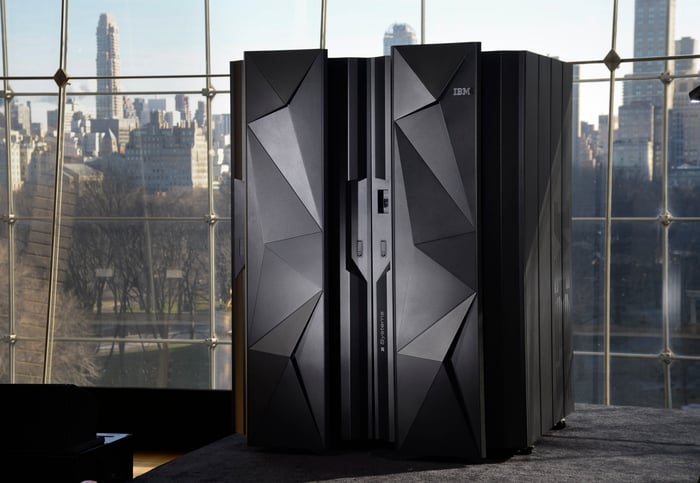It's been five years since International Business Machines (IBM 1.13%) has been able to grow its quarterly revenue. The declines have been shockingly large at times, particularly in 2015, when annual revenue tumbled 12%. That steep drop-off was due mostly to divestitures and currency effects, so the headline number doesn't tell the whole story. Even on an adjusted basis, though, IBM's revenue has been slowly and steadily receding since 2012.
The first quarter of this year brought renewed concern that a return to revenue growth wasn't near. The stock slumped after IBM fell short of revenue expectations, driven by delays in closing a few large services deals. At least one of those deals, a $1.7 billion cloud computing pact with a major U.K. bank, has since been sealed, but the stock remains in the doldrums.
For IBM to sustainably return to revenue growth, its growth businesses, what it calls "strategic imperatives," must become large enough to offset declines in legacy businesses. While the strategic imperatives accounted for 42% of total revenue over the past 12 months, growing by 12% year over year in the latest quarter, it still wasn't enough.
Even so, there's a chance that IBM can put an end to its streak of revenue drops later this year. The company is expected to launch a new mainframe system during the second half, which should trigger an upgrade cycle for its existing mainframe customers. This boost to sales may be enough for IBM to report its first quarter of revenue growth in half a decade.

The IBM z13 mainframe. Image source: IBM.
The mainframe refresh bump
The last major mainframe refresh came in January 2015, when IBM launched the z13. The company invested $1 billion to develop the system, capable of processing 2.5 billion transactions per day while offering real-time encryption and embedded analytics. Fully utilized, IBM claimed the z13 could offer a 49% lower total cost of ownership than a private cloud comprised of commodity hardware.
The launch of the z13 induced a surge in mainframe sales, the typical pattern in IBM's mainframe business. Mainframe sales soared 130% year over year during the first quarter of 2015, driving a $400 million revenue increase in the company's hardware segment. Three quarters of slower mainframe sales growth followed, with a significant decline in the first quarter of 2016 as the launch was lapped.
The next big mainframe refresh will come late this year, according to CFO Martin Schroeter during the latest earnings conference call. Depending on the timing, the third or fourth quarter will see a major boost in mainframe sales. The launch of the z13 wasn't enough to return IBM to revenue growth, but it came at a time when revenue was tumbling due to currency fluctuations. Adjusted revenue was actually flat during the first quarter of 2015 thanks to higher mainframe sales.
IBM is in a stronger position today than it was two years ago. Its growth businesses are bigger, and it expects to produce a small increase in adjusted earnings per share this year. The upcoming mainframe launch may be just enough to end the streak of revenue declines.
Long-term growth
The mainframe launch won't be enough to return IBM to sustained growth, as the initial sales bump will wear off after a few quarters. For revenue to begin growing consistently again, IBM's growth businesses need to maintain their momentum. The cloud business is a major growth opportunity for IBM, and it will be driven by large enterprises with complicated IT infrastructures looking to move to the cloud. Cloud revenue totaled $14.6 billion over the past 12 months, with the cloud-as-a-service annual run rate growing by nearly 60% in the latest quarter.
IBM's long-term goal is to produce low single-digit revenue growth, mid-single-digit pre-tax income growth, and high single-digit EPS growth annually. Looking at the company's performance over the past few years, these targets may seem optimistic. I wouldn't expect IBM to hit them anytime soon, but a return to even sluggish revenue growth, aided by the mainframe refresh, would go a long way in changing the narrative that keeps knocking down the stock.





